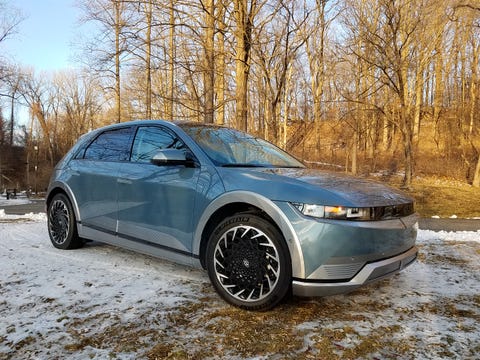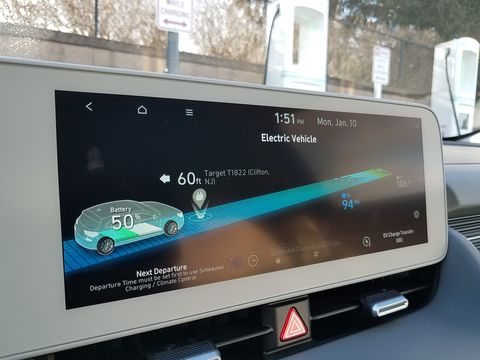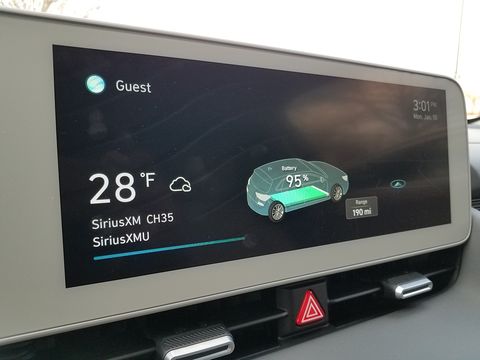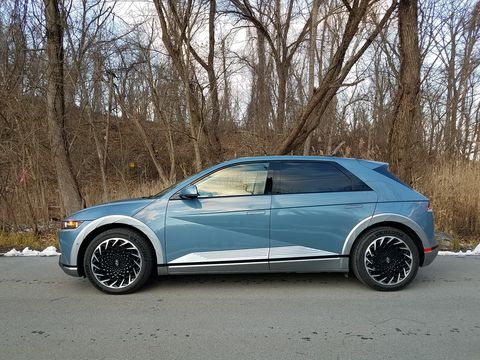One of the Best Affordable Electric Cars
Legacy automakers are finally getting the hang of this EV thing, despite chip shortages and stingy production that make it hard to chip into Tesla’s sales lead. That includes the gap opened by the Model Y SUV, which Elon Musk projects will become the world’s best-selling car this year.
That Model Y is the tall-riding target for models like the Hyundai Ioniq 5, Ford Mustang Mach-e and Volkswagen ID.4. And though the all-new Ioniq 5 can’t match Tesla’s driving range or efficiency, it’s otherwise a revelation: A movie-star-handsome EV with crowd-pleasing talent and rapid 350-kilowatt charging to cut downtime during road-trip adventures.
Let’s start with those looks, because many prospective buyers will do just that. Whether or not Hyundai designers taped Giorgetto Guigiaro’s works to their studio walls — not his early curvy Ferraris, BMW’s and Iso’s, but faceted stuff like the Lancia Delta, Saab 9000 and VW Scirocco — the inspiration shines through. From its Audiesque clamshell hood and rectangular headlamps to its origami door folds and pixellated lighting signatures, the Ioniq 5 makes the “Hello, Future” statement that’s been garbled by so many EV makers. You know a car looks good when it basically silences Internet loudmouths. The Ioniq accomplishes all this without the painful whimsy or sci-fi obviousness that mars some EVs. As a clean-sheet basis for future EVs on this dedicated BEV platform, including Kia’s audacious EV6 and the Genesis GV60, Hyundai’s Parametric Pixel design theme is off to one felicitous start.
The interior hews more closely to familiar EV design tropes. That includes a minimal and mildly antiseptic vibe, a Jobsian white-gray color scheme, and a pair of slim 12-inch displays standing sentry above finely damped air vents.
Yet in reliable Hyundai-Kia-Genesis fashion, the materials, ergonomics, features and details are so strong that they overcome any class-related misgivings, along with much of the competition. The less said about VW’s hapless infotainment system the better. But the Hyundai’s hoodless driver’s cluster and center touchscreen also beat the Mach-e’s, despite the Ford’s ostensibly more dramatic Tesla-like portrait display. That includes crisper renderings and cooler driver readouts, a superior nav system and voice controls, and no-fuss operation on the fly. Tunes also top Ford, VW or Tesla, at least via the muscular premium Bose audio on my Limited AWD model.
Nailed details include space-saving seats that don’t sacrifice style or comfort. Ambient light spills from recesses in softly padded armrests. There’s sturdy metal trim and glass-paneled climate switches whose haptic functions actually work, every time. A panoramic sunroof shade opens in fancy clamshell style. I’d trade the powered driver’s-seat legrest for a thigh extender, but how many cars even worry about a nap behind the wheel?
Hyundai says its column-mounted electronic shifter is the result of deep ergonomic study, and it shows. Just twist the stalk for Drive or Reverse, and press the button for Park. Sounds simple, until one struggles with the glitchy electronic shifters in some cars. Signal a turn and a real-time view of blind spots fills orbs in the driver’s cluster. An optional head-up display, the brand’s first, flashes augmented-reality directional arrows. Hyundai’s semi-autonomous systems, including adaptive cruise control with confident lane-keeping steering assist, are also on par with several luxury makes. That now includes machine learning that can study a driver’s behavior, even when cruise control isn’t activated, to adjust acceleration and following distance.
With no transmission tunnel, and a sliding “Universal Island” center console incorporating a well-placed, 15-watt wireless charging pad, drivers or front passengers can exit the vehicle from either side, or plop a purse or backpack onto the flat floor. A good-size bag can also fit in the open bin beneath the folding center armrest.
An enormous 118.1-inch wheelbase and corner-set wheels lend the Ioniq 5 a linebacker’s stance. That wheelbase stretches four inches beyond the big Hyundai Palisade’s, and past even the Audi Q7’s 117.9 inches. That helps carve out six percent more passenger volume than the Ford or VW. There’s a class-leading 39.4 inches of rear legroom, nearly two more than the ID.4, and about three more than an ICE-powered Mercedes-Benz GLC or E-Class. Lengthy rear doors with equally generous glass offer smooth entry to reclining rear seats. Those 60/40 split-folders can slide five inches to expand cargo space.
With seats raised, the Ford and VW claim slightly more cargo room than the Ioniq 5’s 27.2 cubic feet, but the Hyundai still tops an Audi Q5. The Hyundai’s 59.3 cubes of seat-down space virtually match the Mach-e’s 59.7, but trail the VW’s 64.2 cubes.
A lot of this stuff I expected. What I didn’t expect was how swift, secure and all-around-charming the Ioniq 5 would be on the road.
Hyundai says the dual-motor Ioniq 5 AWD will scorch 60 mph in less than five seconds, and a few impromptu runs suggested that 4.8 seconds sounds about right. That’s not Ludicrous-quick, but still a fantasy in any ICE-powered mainstream SUV. Dual-motor Hyundais dial up a healthy 320 horsepower and 446-pound feet of torque. Their all-weather performance and traction adds $3,500 to the bottom line, or $3,900 in a Limited.
The new skateboard e-GMP platform keeps its entire battery, which holds 77.4 kWh in nearly all versions, between the axles for more planted performance. So equipped, a rear-drive Ioniq 5 sneaks past the magic mark with a 303-mile range and a frugal 114 mpge. That single-motor model manages 225 horsepower and 258 pound-feet.
AWD versions sacrifice range for performance, with a still-reasonable 256-mile leash and 98 mpge in combined EPA measures. As noted, that doesn’t touch the 330 miles and 122 mpge of the comparable Model Y AWD. But efficiency tops the Mach-E’s 90 mpge, though the Ford’s larger 88-kWh battery lets it cover 270 miles. Cheater. A vehicle-to-load (V2L) function lets owners charge e-bikes, camping gear, scooters or other gear from the battery.
Public charging could be a prime selling point. The Hyundai’s 800-volt architecture and 697-volt battery allow 350-kilowatt charging that was previously limited to honchos like the Porsche Taycan and Lucid Air. Heck, the six-figure Mercedes EQS is limited to 200 kilowatts. An 18-minute hookup can zap the Ioniq 5 from 10-to-80 percent full in 18 minutes, Hyundai claims. A five-minute bathroom break is enough to add 68 miles, not on par with a gasoline fill-up, but not bad for the bladder-challenged. Point being, the Ioniq 5 becomes that much more viable as a true Interstate cruiser.
Of course, those 350-kilowatt Frankensteins are just now going live in America, including on the Electrify America network that offers two years of free service to Ioniq 5 buyers. A 150-kilowatt EA charger at a Target in New Jersey had to suffice. And that charger was only pushing juice at a sharply reduced rate of roughly 45-kilowatts, or about one-sixth what I’d expect from a 350-kW station that actually stuffs in electrons at closer to 270 kilowatts. The Hyundai added 100 miles of range in 42 minutes; do the math, and you’re indeed looking at 7 or 8 minutes to add 100 miles on a mega-charger. Now we’re talking.
During one long drive, ambient temperatures hovered around 30 degrees; not ideal. Still, even babying the throttle and settling for a chillier cabin in Eco mode, I had a hard time eking out more than 2.7 miles for every onboard kilowatt-hour. That put me on pace for closer to 200 miles than the official 256.
As for road manners, operative words are “supple” and “sophisticated.” While escaping Manhattan, the Ioniq 5’s suspension, including a five-link rear, felt more absorbent than a Bounty roll.
Suspension balance recalls Genesis, with a soft layer of compliance over a band of sinew. There’s real sophistication in the Hyundai’s by-wire steering (with a rack-mounted assist), including variable levels of heft as you toggle through Eco, Normal, Snow and Sport settings.
As with any EV shy of a Porsche Taycan or its Audi RS e-Tron GT cousin, the steering has triple-prophylactic protection against actual road feel. But once I learned to trust the low-planted grip, the Hyundai glided across the surface at a stirring pace.
The compliant suspension sometimes needs to play catch-up when you really crank into corners, but the spirit and spunk is there: A BMW 340i tried to reel the Ioniq 5 in on a two-lane freeway roundabout—they may have just wanted to snap adoring photos, a week-long reaction to the Hyundai—and received nothing but humiliation in return. Strap on some summer rubber and this Hyundai would slay even bigger giants.
Another telltale for grip is 20-inch alloy wheels in a kaleidoscope pattern, shod with energy-saving Michelin Primacy tires with a 255/45/20R spec in the rear. They’re even girthier than the 245/45/20’s on the Mach-e GT Performance edition. And I’m dying for a back-to-back test against the Mach-e, because my hunch is the Hyundai handles every bit as well. For one, the Hyundai’s 14.3:1 steering ratio is quicker than the Mach-e’s at 15.3:1, though not as crazy-fast, or at times darty, as the Tesla’s 10.3:1.
An unusually generous five regen levels, selectable via paddle shifters, range from a coast mode to the strongest “iPedal” setting. Levels 1 and 2 are well-suited to the highway or spirited runs, mimicking engine braking to varying degrees. Level 3 and iPedal can feel a bit boat-anchor in certain situations, but both allow one-pedal driving, with iPedal delivering settled, confident stops at lights or in heavy traffic. The brake pedal itself initially felt a bit mashed-potatoes. But a deep dive into the multifarious center screen revealed a separate Sport mode for the brake pedal that elicited notably firmer response.
Most complaints are minor. The steep rear glass badly needs a wiper. The afterthought frunk might fit a laptop. To some eyes, pricing might also seem pulled from the luxury Book of Genesis, though that’s true for most any EV. Our 320-hp Limited AWD sells for $55,725. EV fans can thank $7,500 in federal largesse to bring prices closer to SUV reality, or $48,225 for that top-dog version.
Enthusiasts may skip a smaller-battery base-model SE that arrives in spring with 168 horses and a 220-mile range; unless its $40,925 price, $33,425 after the tax break, proves irresistible. For $3,950 more, at $44,875, a rear-wheeling SE gets the bigger battery, 225 hp and a solid 303-mile stamina. That seems a square deal for barely $37,000 after credits, especially for range-sensitive types.
As for power-packed versions, the SE AWD model fetches $48,375, or $50,625 for the SEL AWD. Chop the $7,500, and you’re looking at roughly $41,000 to $43,000, on par with the average new 2022 car.
The only real disappointment is familiar: A lack of 50-state supply. Hyundai executives confirmed the Ioniq 5 is only available in the mainly coastal ZEV states, along with Texas, Florida, Illinois, Pennsylvania, Arizona, Virginia and Washington. Yes, those are the states with the most EV prospects, the states where legacy automakers are concentrating limited fire and production at Tesla. But that inevitably leaves some would-be buyers in the lurch, and potentially limits the Ioniq 5’s reach and significance.
That’s a shame. Because this little knockout is one of the best affordable EVs yet, with the style, layout, tech and performance that people have been clamoring for. C’mon, Hyundai: What have you got against the man in Michigan or the gal in South Dakota?
This content is created and maintained by a third party, and imported onto this page to help users provide their email addresses. You may be able to find more information about this and similar content at piano.io





